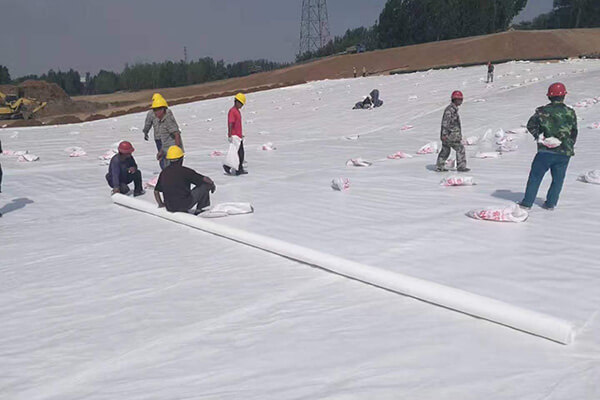Non-woven Geotextile Protects HDPE Geomembrane from Ultraviolet Radiation
At present, the high-grade highways constructed in my country are mainly based on semi-rigid bases, which have high strength and large bearing capacity, but they also have shortcomings such as easy cracking and difficult repair after damage. , And easy to produce early damage, mainly reflection cracks. If the treatment is not timely, other diseases are easy to occur. In particular, rainwater penetrates into the base layer, causing water damage to the road surface, increasing the maintenance cost of the road surface, and seriously affecting the quality and life of the road. In order to suppress or reduce the shrinkage cracks and reflection cracks of the semi-rigid base layer of the pavement LDPE geomembrane for sale, the commonly used method is to set polymer-modified asphalt stress absorbing film and stress absorbing layer on the pavement base layer, or to lay a geosynthetic material proven effective in practice. Among them, the rubber asphalt stress absorbing layer is a flexible functional layer that has the advantages of absorbing stress, delaying the upward development of reflective cracks, resisting water damage, and enhancing the adhesion between the upper and lower layers. However, although the rubber asphalt stress absorption layer has a certain waterproof function, it cannot effectively migrate and eliminate the leakage of reflection cracks, resulting in water damage and erosion of the road surface.
Using asphalt macadam synchronous sealing technology, a rubber asphalt stress absorption layer is set between the underlying layer (new base layer, milling old asphalt pavement or old cement pavement) and the asphalt surface layer, and the upper layer is bonded with polyester nonwoven geotextile factory price to further improve The tensile strength of the stress-absorbing layer; a fine-grained soil layer is laid between the new asphalt surface and the non-woven geotextile. The capillary waterproof layer is formed by using the principle that the permeability coefficient of the fine-grained soil layer in the unsaturated state is different from that of the non-woven geotextile. The drainage function of the non-woven geotextile can effectively prevent rainwater from infiltrating and transferring down the cracks.

In the anti-seepage project, when the high-density polyethylene geomembrane is used as the anti-seepage layer, according to the design requirements, a layer of polyester nonwoven geotextile for sale with a density of not less than 600 g/㎡ is laid on the high-density polyethylene geomembrane as a protective layer, Non-woven geotextile should also be laid under the high-density polyethylene geomembrane as a protective layer. When the landfill is not covered, the non-woven geotextile can protect the HDPE geomembrane from UV aging. The non-woven geotextile can protect the high-density polyethylene wholesale LDPE geomembrane from damage from sharp objects at the bottom and friction caused by sudden uneven load under long-term load. The anti-ultraviolet performance of non-woven geotextile is related to its thickness. Polyester spunbond needle-punched non-woven geotextile has excellent UV protection properties. Compared with polyester staple fiber needle-punched nonwoven geotextiles, the influence of ultraviolet rays on the former mainly occurs on the surface fibers.
In engineering design, two materials with different particle sizes often contact each other. In order to prevent the two materials with different particle sizes from infiltrating each other under the action of water and losing the meaning of designing the structure and ensuring the normal operation of the project, an isolation layer will be set between the two materials. The wholesale polyester nonwoven geotextile has high strength, good water permeability, and a certain thickness, which can meet the needs of engineering design. For example, in China’s self-developed slab ballastless track design, short polypropylene fiber non-woven geotextile is set as an isolation layer between the trackbed slab and the foundation, which is mainly to prevent the deformation of the bridge superstructure from transmitting the force to the trackbed slab, causing it Warpage and deformation have certain heat insulation and shock isolation effect.
